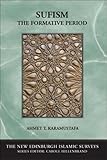Sufism : the formative period / Ahmet T. Karamustafa.
Material type: TextSeries: New Edinburgh Islamic surveysPublication details: Edinburgh : Edinburgh University Press, ©2007.Description: 1 online resource (xii, 202 pages)Content type:
TextSeries: New Edinburgh Islamic surveysPublication details: Edinburgh : Edinburgh University Press, ©2007.Description: 1 online resource (xii, 202 pages)Content type: - 9780748628971
- 0748628975
- 9786610833955
- 6610833958
- 297.409 22
- BP188.5 .K37 2007eb
- online - EBSCO
| Item type | Current library | Call number | URL | Status | Notes | Barcode | |
|---|---|---|---|---|---|---|---|
 eBook
eBook
|
Biblioteca "Angelicum" Pont. Univ. S.Tommaso d'Aquino Nuvola online | online - EBSCO (Browse shelf(Opens below)) | Online access | Not for loan (Accesso limitato) | Accesso per gli utenti autorizzati / Access for authorized users | (ebsco)194158 |
Browsing Biblioteca "Angelicum" Pont. Univ. S.Tommaso d'Aquino shelves, Shelving location: Nuvola online Close shelf browser (Hides shelf browser)

|

|

|

|

|

|

|
||
| online - EBSCO The studia Philonica annual. studies in Hellenistic Judaism / Volume XXVI : | online - EBSCO Studies in Shinto and shrines / | online - EBSCO Studying Islam in the Soviet Union / | online - EBSCO Sufism : the formative period / | online - EBSCO Sufism and theology / | online - EBSCO Superstition : belief in the age of science / | online - EBSCO Surviving death / |
Includes bibliographical references and index.
The Sufis of Baghdad -- Mystics outside Baghdad -- The spread of Baghdad Sufism -- Specialised Sufi literature -- Formation of communities -- Sainthood triumphant.
Print version record.
This book is a comprehensive historical overview of the formative period of Sufism, the major mystical tradition in Islam, from the ninth to the twelfth century CE. Based on a fresh reading of the primary sources and integrating the findings of recent scholarship on the subject, the author presents a unified narrative of Sufism's historical development within an innovative analytical framework. Karamustafa gives a new account of the emergence of mystical currents in Islam during the ninth century and traces the rapid spread of Iraq-based Sufism to other regions of the Islamic world and its fusion with indigenous mystical movements elsewhere, most notably the Mal?matiyya of northeastern Iran. He analyses extensively the formation of Sufi communities, the imbrication of Sufi sainthood with popular saints' cults as well as nonconformist dimensions of Sufism and fully explicates the reasons for the increasing social prominence of the Sufi mode of piety during this early period in Islamic history. Key Features Strikes a balance between social and intellectual history Identifies and articulates questions of interest to scholars, students and general readers Consistently locates Sufism within its broader social and intellectual context
English.


